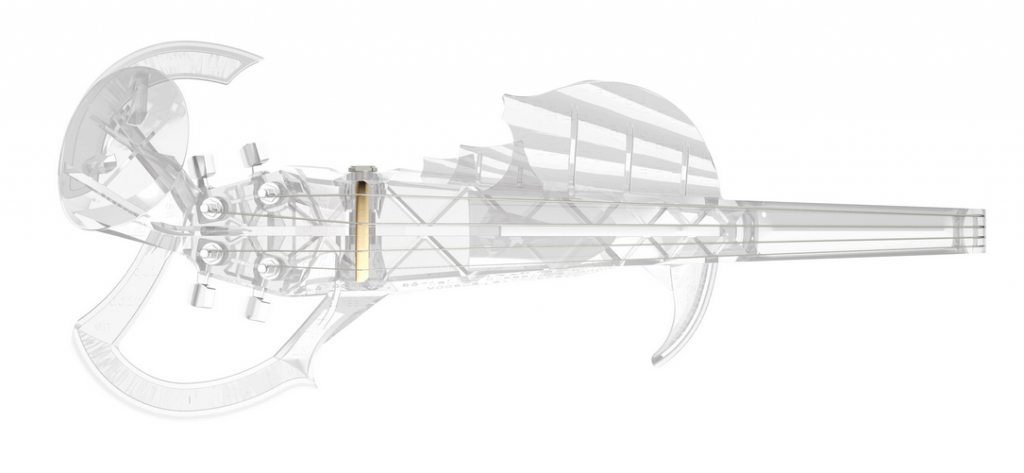The First SLA 3D Printed Electric Violin is Here! It’s Amazing & It’s Clear!
 Over the past year or so, we have really begun to see musicians and designers utilizing 3D printing technology in order to create unique, custom, and incredibly sounding musical instruments. We’ve seen everything from guitars to cellos, flutes and violins all fabricated on 3D printers of all kinds. Most of these instruments have been created either on FDM/FFF based 3D printers similar to those found on many of our desktops at home, or large industrial level selective laser sintering (SLS)machines. Now, however, one musician, named Laurent Bernadac had taken things up another notch. Laurent Bernadac, you see, has taken it upon himself to create a fully playable electric violin which has been printed using stereolithographic (SLA) technology. This has allowed him to create one of the most astonishing violins you will ever see.
Over the past year or so, we have really begun to see musicians and designers utilizing 3D printing technology in order to create unique, custom, and incredibly sounding musical instruments. We’ve seen everything from guitars to cellos, flutes and violins all fabricated on 3D printers of all kinds. Most of these instruments have been created either on FDM/FFF based 3D printers similar to those found on many of our desktops at home, or large industrial level selective laser sintering (SLS)machines. Now, however, one musician, named Laurent Bernadac had taken things up another notch. Laurent Bernadac, you see, has taken it upon himself to create a fully playable electric violin which has been printed using stereolithographic (SLA) technology. This has allowed him to create one of the most astonishing violins you will ever see.
Called the 3D Varius, not only does it play crystal clear music, but its bout (body), neck and the majority of the rest of the instrument is 3D printed in a clear material as well.
“The goal was to create a unique design, inspired by the shape of a traditional violin, and refining the forms and supports to obtain a more aesthetic design, simpler, lighter and transparent,” Bernadac explains. “Our choice of 3d-printing technology is stereolithography* because of its exceptional printing definition and the resistance of its printed objects.”
Bernadac’s design is actually based on a Stradivarius violin; a violin which was built by members of the Stradivari family during the 17th and 18th centuries. It is 3D printed in one single piece, which strays quite a bit from traditional violin production, using UV light to cure a liquid photo-reactive resin. This method of 3D printing builds up highly detailed and precise objects in a matter of hours.
“Combining the precision and power of 3D-printing with ancient violin-making skills, its innovative design, in the service of violinist, marks a further step towards the perfect symbiosis between musician and instrument,” Bernadac explains.
Once the violin was 3D printed, it required a quick clean-up before being put under a strong UV light in order to completely polymerize the entire structure. This ensures that it is completely cured and as strong as can be. Then the surfaces of the violin, which comes into contact with the strings or the musician’s body, are sanded down in order to “offer optimal playing comfort”. It’s then off to stringing the instrument, a process which must be done with complete precision and care in order to ensure that it plays with the clarity it is capable of.
While Bernadac says that the violin is fully 3D printed, in actuality it isn’t entirely fabricated on a 3D printer, as of course the strings are not 3D printed, nor are the tuning pegs. However, the majority the instrument in fact is.
As you can hear in the videos on this page, the violin’s sound is as crystal clear as the instrument itself. Could SLA 3D printing prove to be the preferred printing method for 3D printing musical instruments? Bernadac’s 3D Varius may prove this to be true. What do you think about this unique, yet beautiful 3D printed violin? Discuss in the 3D Varius forum thread on 3DPB.com.
Subscribe to Our Email Newsletter
Stay up-to-date on all the latest news from the 3D printing industry and receive information and offers from third party vendors.
Print Services
You May Also Like
3YOURMIND’s New AI Speeds Up Technical Drawing Analysis for Part Identification
German-US software provider 3YOURMIND, a longtime innovator in the additive manufacturing (AM) design space, has announced a new feature for its signature Part Identification software: a Technical Drawing Analysis function...
Bassetti Weaves a Digital Thread through 3D Printing
According to the latest market research report from Additive Manufacturing (AM) Research, “AM Software Markets 2025: Analysis, Data and Forecast,” software is the next frontier for the sector. This segment...
Strategic Advantage of 3D Printing in a Time of Import Tariffs
The value of 3D printing in mitigating the impact of import tariffs is often underestimated. Now is the time to leverage 3D printing to adapt and profit from the opportunities...
AM Forum 2025: Lovely Days in Berlin
AM Forum is a yearly two-day event in Berlin. Rather than being just a national gathering, the AM Forum addresses numerous international and Europe-wide themes. Speakers from around the world...




























